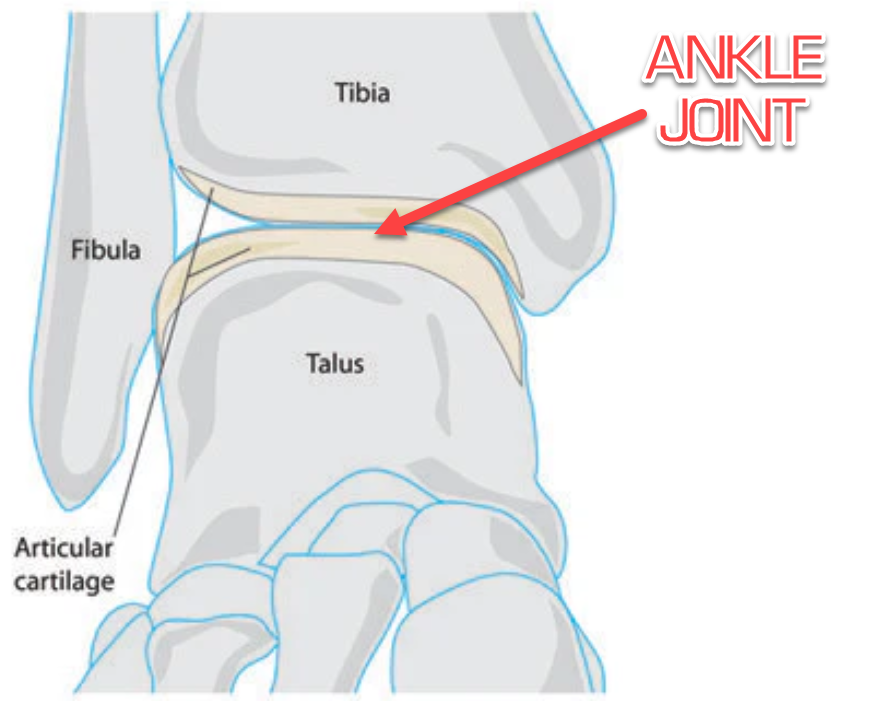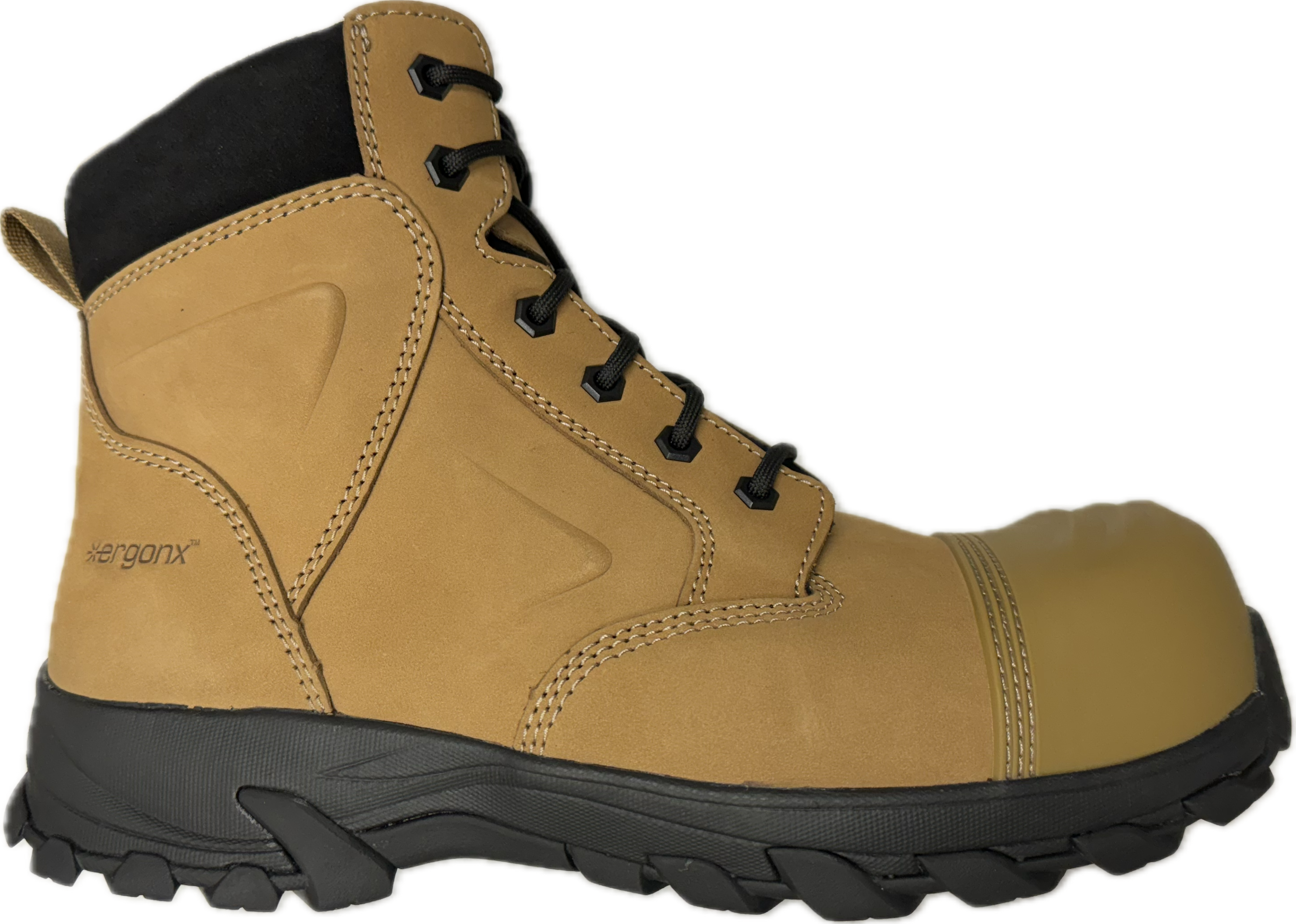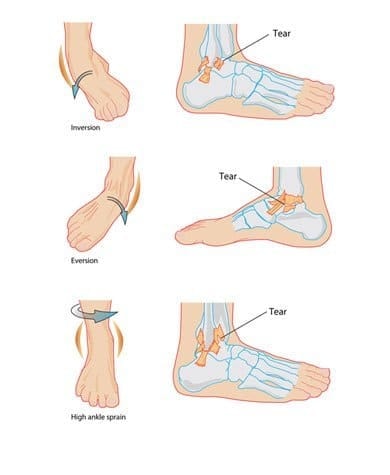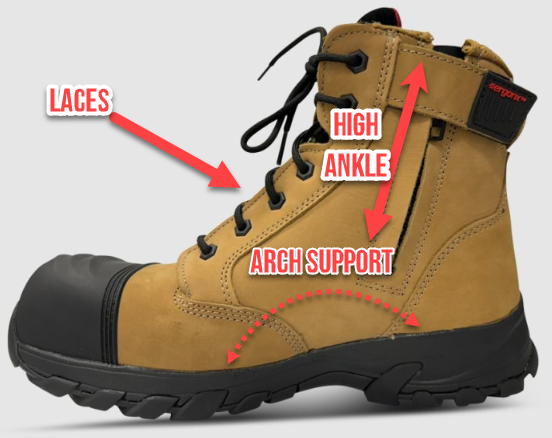What does the ankle protection do for us?
The ankle is responsible for bearing the weight of the body and acting as the pivoting point between the lower leg and the foot. One of its main roles is to maintain balance and stability during movement.
A complex network of ligaments, tendons, muscles, and joints work together to support the ankle. These structures also take part in providing shock absorption and preventing injury during physical activity.
The subtalar joint is a crucial component of the ankle, responsible for facilitating side-to-side movement and regulating the inward and outward rotation of the foot. Another key part of the ankle is the talocrural joint. It is essential to safeguard both the subtalar and talocrural joints to preserve the overall health and function of the ankle.
 Ankle support is important for ankle protection in safety boots because the job is unpredictable. Hiking shoes will often not cut it as they lack a protective toe box.
Ankle support is important for ankle protection in safety boots because the job is unpredictable. Hiking shoes will often not cut it as they lack a protective toe box.
Importance of Ankle Support
Ankle support is crucial for maintaining stability and balance during various activities, including hiking, working, and everyday wear. The ankle joint bears the weight of the body and acts as a pivoting point between the lower leg and the foot. A complex network of ligaments, tendons, muscles, and joints work together to support the ankle, providing shock absorption and preventing injury during physical activity.
Without proper ankle support, the risk of sprains, strains, and other injuries increases significantly. This is especially true for individuals who spend long hours on their feet or engage in physically demanding tasks. By choosing footwear with good ankle support, you can enhance your overall comfort and reduce the likelihood of injuries, ensuring that you stay active and pain-free throughout the day.
 Ankle support is important for walking on uneven ground on the worksite. Great ankle support can help to reduce the chance of injury from ankle sprains.
Ankle support is important for walking on uneven ground on the worksite. Great ankle support can help to reduce the chance of injury from ankle sprains.
Ankle Injuries in the Workplace
Ankle injuries are common in the workplace, particularly in industries that require physical labour or involve working on uneven ground. According to the Bureau of Labor Statistics, ankle injuries account for a significant percentage of workplace injuries. These injuries can range from minor sprains to severe fractures, often resulting in lost workdays and decreased productivity.
Wearing work boots with good ankle support can help prevent twists and reduce fatigue, making them an essential part of workplace safety. Proper ankle support stabilizes the foot, reducing the risk of rolling or twisting the ankle on uneven surfaces. This not only helps prevent injuries but also enhances overall comfort, allowing workers to perform their tasks more efficiently and safely.
 Ankle injuries are common in unpredictable environments. Work boots with a high ankle support can help to minimize this risk.
Ankle injuries are common in unpredictable environments. Work boots with a high ankle support can help to minimize this risk.
Work boots that provide ankle support
Work boots with the best ankle support are crucial for those who work in physically demanding environments or spend long periods on their feet. Along with protecting the feet, work boots that stabilize the ankles offer additional benefits, such as preventing twists and reducing fatigue.
Below are several features to keep an eye out for when shopping for a pair of work boots that are ankle-friendly:
High ankle shafts: Safety boots with high ankle shafts that surround the ankles help prevent them from rolling or twisting excessively.
Adjustable lacing: A safety boot with laces allows for a customized and snug fit, ensuring that the ankle is held securely in place. Laces also make for a more comfortable shoe as it prevents the foot from slipping around inside the shoe. For the perfect fit, there should also be enough room in the toe box to wiggle your toes.
Built-in arch support: Built-in orthotics are designed to provide added arch support, cushioning, and correct foot misalignment. In addition to keeping your feet in a more neutral position (limiting excessive pronation), they can improve overall posture and help keep you pain-free throughout the day.
Level forefoot and rearfoot alignment: Forefoot and rearfoot alignment refer to the positioning of the front part of the foot relative to the heel. In a quality work boot, these two should be on the same plane so that the foot does not twist and turn too much over uneven surfaces. This promotes stability and balance.
 Arch support will hep to relieve foot pain. When paired with other safety features like a high ankle, no-slip outsole, protective toe caps, padded tongue and a thick sole (non-slip) it makes you safer at work
Arch support will hep to relieve foot pain. When paired with other safety features like a high ankle, no-slip outsole, protective toe caps, padded tongue and a thick sole (non-slip) it makes you safer at work
Other factors to consider when purchasing work boots
Reviews from other customers and professional advice can be great tools to turn to when choosing your next pair of boots. Here are some additional factors to keep in mind:
Safety features – These can include things like a toe cap, electrical protection, anti-static, and waterproof precautions
Price – Work boots can vary in price, while it may be tempting to go for a cheaper option, investing in a quality pair of boots can save you money and foot discomfort in the long run
Durability – Your boots should be able to withstand wear and tear. Look for boots with quality construction and strong construction.
Mesh upper – A mesh upper enhances breathability and comfort, making the boots suitable for long hours of wear.
Maintenance and Care
To ensure that your work boots or hiking boots continue to provide good ankle support, it’s essential to maintain and care for them properly. This includes:
Regular cleaning and conditioning: Clean your boots regularly to remove dirt and debris. Conditioning the leather prevents cracking and drying out, extending the life of your boots.
Waterproofing treatments: Apply waterproofing treatments to protect your boots from water and moisture, ensuring they remain durable and effective in various conditions.
Replacing worn-out insoles and laces: Over time, insoles and laces can wear out, affecting the fit and support of your boots. Replace them as needed to maintain a snug and comfortable fit.
Proper storage: Store your boots in a cool, dry place to prevent damage from heat and moisture. Avoid leaving them in direct sunlight or damp areas.
By following these tips, you can help extend the life of your work boots or hiking boots and ensure that they continue to provide the ankle support you need to stay safe and comfortable on the job or on the trail.
When should I replace my work boots?
Whether you are using work boots or a hiking boot, it is recommended to replace them around one year’s time if worn daily. Over time, work boots experience wear and tear from use and exposure to the environment. This can cause the soles to become worn down and less efficient at providing adequate support and protection.
Get in touch with us
If you have any questions or would like to learn more about safety boots, composite toe boots, and footwear that can help prevent construction job injuries, please comment below or reach out to us at ergonx.com.au. We would love to hear from you!

